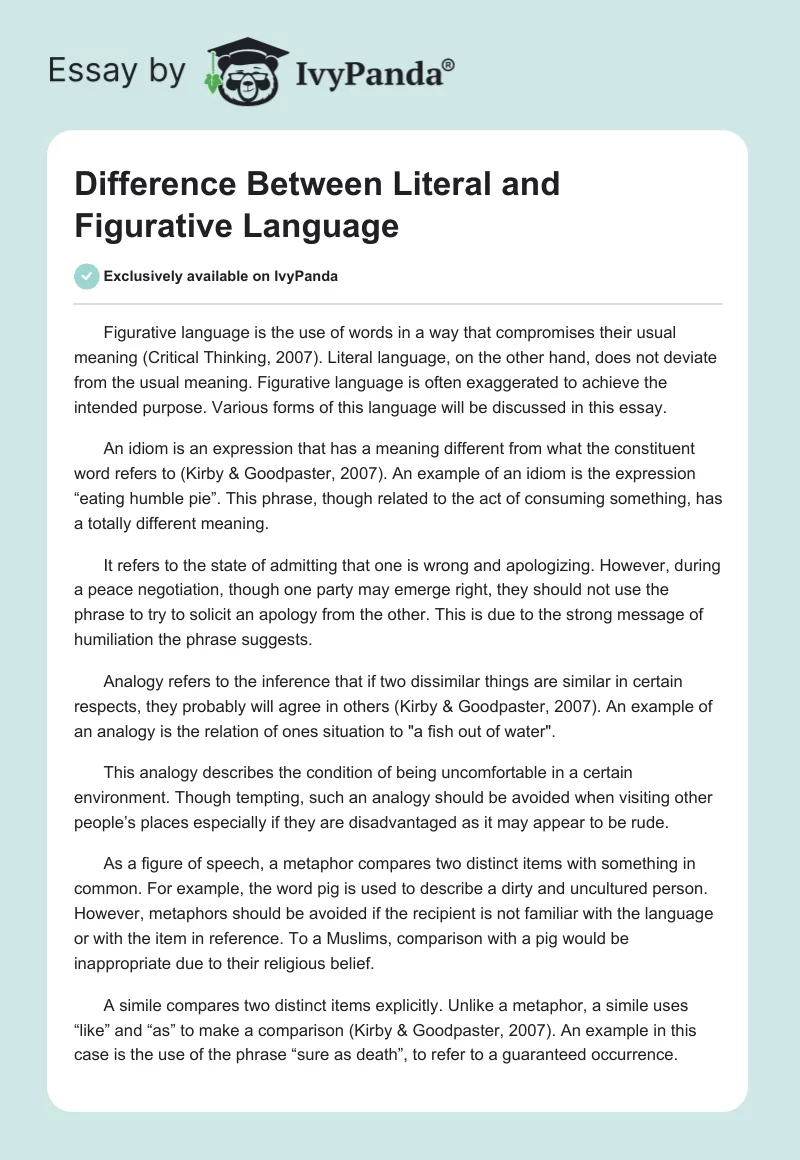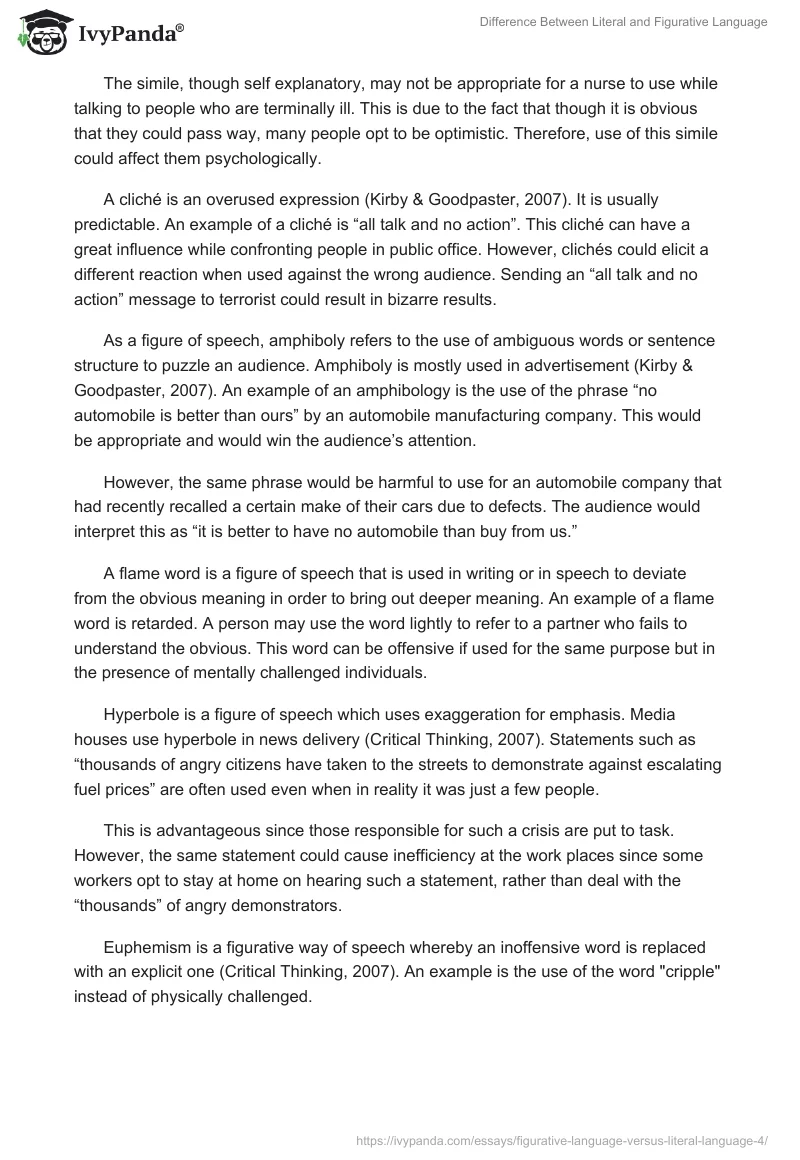Figurative language is the use of words in a way that compromises their usual meaning (Critical Thinking, 2007). Literal language, on the other hand, does not deviate from the usual meaning. Figurative language is often exaggerated to achieve the intended purpose. Various forms of this language will be discussed in this essay.
An idiom is an expression that has a meaning different from what the constituent word refers to (Kirby & Goodpaster, 2007). An example of an idiom is the expression “eating humble pie”. This phrase, though related to the act of consuming something, has a totally different meaning.
It refers to the state of admitting that one is wrong and apologizing. However, during a peace negotiation, though one party may emerge right, they should not use the phrase to try to solicit an apology from the other. This is due to the strong message of humiliation the phrase suggests.
Analogy refers to the inference that if two dissimilar things are similar in certain respects, they probably will agree in others (Kirby & Goodpaster, 2007). An example of an analogy is the relation of ones situation to “a fish out of water”.
This analogy describes the condition of being uncomfortable in a certain environment. Though tempting, such an analogy should be avoided when visiting other people’s places especially if they are disadvantaged as it may appear to be rude.
As a figure of speech, a metaphor compares two distinct items with something in common. For example, the word pig is used to describe a dirty and uncultured person. However, metaphors should be avoided if the recipient is not familiar with the language or with the item in reference. To a Muslims, comparison with a pig would be inappropriate due to their religious belief.
A simile compares two distinct items explicitly. Unlike a metaphor, a simile uses “like” and “as” to make a comparison (Kirby & Goodpaster, 2007). An example in this case is the use of the phrase “sure as death”, to refer to a guaranteed occurrence.
The simile, though self explanatory, may not be appropriate for a nurse to use while talking to people who are terminally ill. This is due to the fact that though it is obvious that they could pass way, many people opt to be optimistic. Therefore, use of this simile could affect them psychologically.
A cliché is an overused expression (Kirby & Goodpaster, 2007). It is usually predictable. An example of a cliché is “all talk and no action”. This cliché can have a great influence while confronting people in public office. However, clichés could elicit a different reaction when used against the wrong audience. Sending an “all talk and no action” message to terrorist could result in bizarre results.
As a figure of speech, amphiboly refers to the use of ambiguous words or sentence structure to puzzle an audience. Amphiboly is mostly used in advertisement (Kirby & Goodpaster, 2007). An example of an amphibology is the use of the phrase “no automobile is better than ours” by an automobile manufacturing company. This would be appropriate and would win the audience’s attention.
However, the same phrase would be harmful to use for an automobile company that had recently recalled a certain make of their cars due to defects. The audience would interpret this as “it is better to have no automobile than buy from us.”
A flame word is a figure of speech that is used in writing or in speech to deviate from the obvious meaning in order to bring out deeper meaning. An example of a flame word is retarded. A person may use the word lightly to refer to a partner who fails to understand the obvious. This word can be offensive if used for the same purpose but in the presence of mentally challenged individuals.
Hyperbole is a figure of speech which uses exaggeration for emphasis. Media houses use hyperbole in news delivery (Critical Thinking, 2007). Statements such as “thousands of angry citizens have taken to the streets to demonstrate against escalating fuel prices” are often used even when in reality it was just a few people.
This is advantageous since those responsible for such a crisis are put to task. However, the same statement could cause inefficiency at the work places since some workers opt to stay at home on hearing such a statement, rather than deal with the “thousands” of angry demonstrators.
Euphemism is a figurative way of speech whereby an inoffensive word is replaced with an explicit one (Critical Thinking, 2007). An example is the use of the word “cripple” instead of physically challenged.
It would be appropriate to use this word while warning teenagers of dangers of drunk driving. This is not the case though when talking to people who are already physically challenged. It would be insensitive to use this would in such a case.
Colloquialism refers to informal expressions used by a group of people of the same age (Critical Thinking, 2007). An example is the use of the word “dude” for man. This is appropriate when speaking to peers since it helps one to connect with them as opposed to using formal words such as “sir”. However, the use of the word “dude” in a formal setting could appear as disrespect.
In conclusion, figurative language is a useful tool when properly applied in communication. As opposed to literal language, figurative language is rich in many aspects of communication such as etiquette. However, figurative language should be used carefully to avoid misunderstanding. Different circumstances elicit different interpretations thus caution should be practiced while exercising figurative speech.
References
Critical Thinking. (2007). Web.
Kirby, G.R., & Goodpaster, J.R. (2007). Thinking. New Jersey: Prentice Hall.


